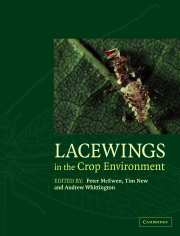Book contents
- Frontmatter
- Contents
- List of contributors
- Preface
- PART 1 Lacewing systematics and ecology
- PART 2 Lacewings in crops
- PART 3 Principles
- PART 4 Case studies
- Introduction to Part 4
- CHAPTER 18 Micromus tasmaniae: a key predator on aphids on field crops on Australasia?
- CHAPTER 19 Preliminary notes on Mallada signatus (Chrysopidae) as a predator in field crops in Australia
- CHAPTER 20 An evaluation of lacewing releases in North America
- CHAPTER 21 Chrysoperla externa and Ceraeochrysa spp.: potential for biological control in the New World tropics and subtropics
- CHAPTER 22 Comparative plant substrate specificity of Iberian Hemerobiidae, Coniopterygidae, and Chrysopidae
- CHAPTER 23 Lacewings in Sardinian olive groves
- CHAPTER 24 Lacewing occurrence in the agricultural landscape of Pianura Padana
- CHAPTER 25 Lacewings and snake-flies in Piedmont vineyards (northwestern Italy)
- CHAPTER 26 Control of aphids by Chrysoperla carnea on strawberry in Italy
- CHAPTER 27 Artificial overwintering chambers for Chrysoperla carnea and their application in pest control
- CHAPTER 28 Lacewings in Andalusian olive orchards
- CHAPTER 29 The green lacewings of Romania, their ecological patterns and occurrence in some agricultural crops
- CHAPTER 30 Biological control with Chrysoperla lucasina against Aphis fabae on artichoke in Brittany (France)
- PART 5 Conclusion
- Taxonomic index
- General index
CHAPTER 22 - Comparative plant substrate specificity of Iberian Hemerobiidae, Coniopterygidae, and Chrysopidae
Published online by Cambridge University Press: 04 May 2010
- Frontmatter
- Contents
- List of contributors
- Preface
- PART 1 Lacewing systematics and ecology
- PART 2 Lacewings in crops
- PART 3 Principles
- PART 4 Case studies
- Introduction to Part 4
- CHAPTER 18 Micromus tasmaniae: a key predator on aphids on field crops on Australasia?
- CHAPTER 19 Preliminary notes on Mallada signatus (Chrysopidae) as a predator in field crops in Australia
- CHAPTER 20 An evaluation of lacewing releases in North America
- CHAPTER 21 Chrysoperla externa and Ceraeochrysa spp.: potential for biological control in the New World tropics and subtropics
- CHAPTER 22 Comparative plant substrate specificity of Iberian Hemerobiidae, Coniopterygidae, and Chrysopidae
- CHAPTER 23 Lacewings in Sardinian olive groves
- CHAPTER 24 Lacewing occurrence in the agricultural landscape of Pianura Padana
- CHAPTER 25 Lacewings and snake-flies in Piedmont vineyards (northwestern Italy)
- CHAPTER 26 Control of aphids by Chrysoperla carnea on strawberry in Italy
- CHAPTER 27 Artificial overwintering chambers for Chrysoperla carnea and their application in pest control
- CHAPTER 28 Lacewings in Andalusian olive orchards
- CHAPTER 29 The green lacewings of Romania, their ecological patterns and occurrence in some agricultural crops
- CHAPTER 30 Biological control with Chrysoperla lucasina against Aphis fabae on artichoke in Brittany (France)
- PART 5 Conclusion
- Taxonomic index
- General index
Summary
INTRODUCTION
The biology of the species in the order Neuroptera is generally poorly known. In the species of Coniopterygidae and Hemerobiidae, data on the plant substrate specificity are very limited or completely unknown in many taxa, with the majority of existing records being limited to Holarctic species. The bestknown fauna is the European one, where there are many data on the capture of numerous species on different plants. However, there is little published information on the autoecology of Coniopterygidae (Meinander, 1972, 1990; Aspöck et al., 1980) and Hemerobiidae (Hinke, 1975; Laffranque & Canard, 1975; Miermont & Canard, 1975; Neuenschwander, 1975, 1976; Samson & Blood, 1979; Garland, 1981; New, 1984), and ecological studies on both families are very scarce (see references in Aspöck et al., 1980 and New, 1989).
In contrast, the biology of the species in the family Chrysopidae is relatively well known. Data on the preferences of green lacewings for plant substrates are very abundant in many taxa, with the majority of existing records likewise being limited to Holarctic species. The best-known fauna is also the European one, where there are many data on the capture of numerous species on different plants, and also there are many articles on the autoecology of chrysopids (see references in Aspöck et al., 1980; Canard et al., 1984; New, 1989).
With reference to the Iberian fauna of these three families, there is apparently much information about the faunistics in the numerous papers published by L. Navás during the early part of this century. However, these references are very unreliable and should not be considered due to the many misidentifications detected, chiefly in Coniopterygidae and Hemerobiidae (Monserrat, 1984, 1986a, 1986b, 1990).
- Type
- Chapter
- Information
- Lacewings in the Crop Environment , pp. 424 - 434Publisher: Cambridge University PressPrint publication year: 2001
- 6
- Cited by



